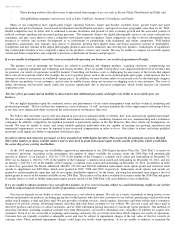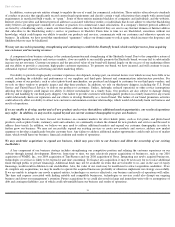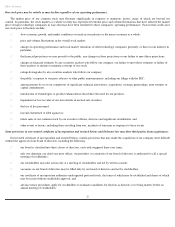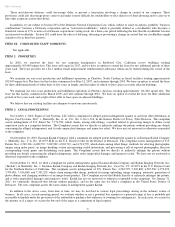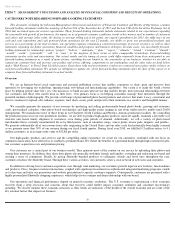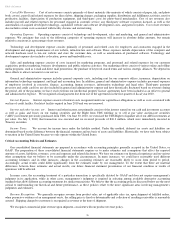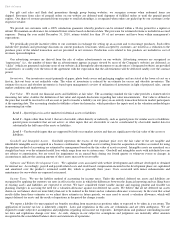Shutterfly 2011 Annual Report Download - page 24
Download and view the complete annual report
Please find page 24 of the 2011 Shutterfly annual report below. You can navigate through the pages in the report by either clicking on the pages listed below, or by using the keyword search tool below to find specific information within the annual report.
Changes in regulations or user concerns regarding privacy and protection of user data could harm our business.
Federal, state and international laws and regulations may govern the collection, use, sharing and security of data that we receive from our
customers. In addition, we have and post on our website our own privacy policies and practices concerning the collection, use and disclosure of
customer data. Any failure, or perceived failure, by us to comply with our posted privacy policies or with any data-
related consent orders,
Federal Trade Commission requirements or other federal, state or international privacy-
related laws and regulations could result in proceedings
or actions against us by governmental entities or others, which could potentially harm our business. Further, failure or perceived failure to
comply with our policies or applicable requirements related to the collection, use or security of personal information or other privacy-
related
matters could damage our reputation and result in a loss of customers.
International expansion will require management attention and resources and may be unsuccessful, which could harm our future business
development and existing domestic operations.
To date, we have conducted limited international operations, but we intend to expand into international markets in order to grow our
business. These expansion plans will require significant management attention and resources and may be unsuccessful. We have limited
experience adapting our products to conform to local cultures, standards and policies. We may have to compete with established local or regional
companies which understand the local market better than we do. In addition, to achieve satisfactory performance for consumers in international
locations it may be necessary to locate physical facilities, such as production facilities, in the foreign market. We do not have experience
establishing, acquiring or operating such facilities overseas. We may not be successful in expanding into any international markets or in
generating revenues from foreign operations. In addition, different privacy, censorship and liability standards and regulations and different
intellectual property laws in foreign countries may cause our business to be harmed.
The success of our business depends on our ability to adapt to the continued evolution of digital photography.
The digital photography market is rapidly evolving, characterized by changing technologies, intense price competition, additional
competitors, evolving industry standards, frequent new service announcements and changing consumer demands and behaviors. To the extent
that consumer adoption of digital photography does not continue to grow as expected, our revenue growth would likely suffer. Moreover, we
face significant risks that, if the market for digital photography evolves in ways that we are not able to address due to changing technologies or
consumer behaviors, pricing pressures, or otherwise, our current products and services may become less attractive, which would result in the loss
of customers, as well as lower net revenues and/or increased expenses.
Purchasers of digital photography products and services may not choose to shop online, which would harm our net revenues and results of
operations.
The online market for digital photography products and services is less developed than the online market for other consumer products. If this
market does not gain widespread acceptance, our business may suffer. Our success will depend in part on our ability to attract customers who
have historically used traditional retail photography services or who have produced photographs and other products using self-
service
alternatives, such as printing at home. Furthermore, we may have to incur significantly higher and more sustained advertising and promotional
expenditures or reduce the prices of our products and services in order to attract additional online consumers to our website and convert them
into purchasing customers. Specific factors that could prevent prospective customers from purchasing from us include:
If purchasers of digital photography products and services do not choose to shop online, our net revenues and results of operations would be
harmed.
The third party software systems that we utilize to assist us in the calculation and reporting of financial data may contain errors that we may
not identify in a timely manner.
We use numerous third party licensed software packages, most notably our equity software and our enterprise resource planning (“ERP”
)
software, which are complex and fully integrated into our financial reporting. Such third party software may contain errors that we may not
identify in a timely manner. If those errors are not identified and addressed timely, our financial reporting may not be in compliance with
generally accepted accounting principles.
Table of Contents
●
the inability to physically handle and examine product samples;
●
delivery time associated with Internet orders;
●
concerns about the security of online transactions and the privacy of personal information;
●
delayed shipments or shipments of incorrect or damaged products; and
●
inconvenience associated with returning or exchanging purchased items.
20





